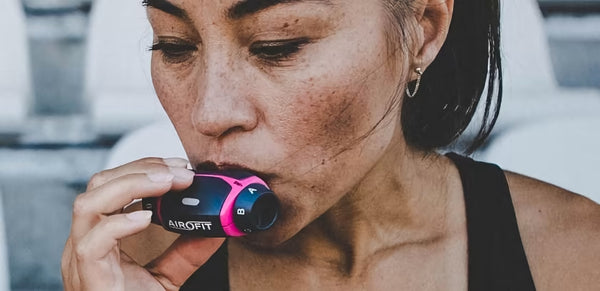Do Respiratory Training Devices Work?
Manufacturers of respiratory training devices (RTDs) claim that with minimal effort, you can dramatically improve your athletic performance. Sounds pretty good, right? But are these gadgets the secret sauce for peak performance, or just another overhyped product?
What Are Respiratory Training Devices?
Respiratory training devices are marketed as “dumbbells for your diaphragm,” and they’re gaining popularity with athletes who want to boost performance. These devices are designed to make breathing harder, so your lung muscles (like the diaphragm and intercostals) get stronger. The idea is that just like you train your legs and arms, you should train your lungs.
Companies like Powerbreathe and Airofit even claim that using their devices for as little as 8-10 minutes a day can boost your performance by up to 8% in eight weeks. That’s a pretty bold claim for something you can do while sitting on your couch.
But are RTDs really the game-changer they’re made out to be, or just a shortcut that sounds too good to be true? Let’s dive into the science.
What Does the Research Say?
For these devices to actually work, a few things need to check out:
- RTDs need to strengthen your lung muscles.
- Stronger lungs need to translate into better athletic performance.
- Lung muscles need to be trainable, like other muscles in your body.
Respiratory Training Devices Might Boost Endurance
Some research suggests there’s science behind the hype. One study looked at 37 sedentary participants to see if RTDs could improve cycling endurance. The participants were divided into three groups: one used respiratory training devices, another did aerobic exercise (like cycling or running), and the control group did nothing. After 15 weeks, both the RTD and aerobic groups showed significant improvements in endurance compared to the control group.
The takeaway? RTDs can improve endurance even without traditional exercise, at least in untrained individuals. (Markov, et. al.)
But it’s not all sunshine and rainbows. The research is mixed—some studies show that RTDs can improve time to exhaustion or boost time-trial performance, while others find no real benefit.
Do They Boost Lung Strength Without Improving Performance?
One study with rowers took a closer look at this. After 10 weeks, the rowers who used RTDs had stronger lung muscles. But when it came to overall performance—VO2 max, strength, or rowing time—there were no significant improvements. (Forbes, et. al.)
Stronger lungs, yes. Better performance? Not necessarily.
The Good News: Respiratory Devices Can Help Distance Runners
Another study with recreational soccer players showed that using a respiratory training device did improve performance. After six weeks of training with Powerbreathe, only the group using RTDs improved their distance running abilities, while the placebo and control groups saw no change. That’s a win for RTDs.
What About Cyclists?
In a study on cyclists, those who used a Powerbreathe device for three weeks increased their time to exhaustion and reduced fatigue. That’s a solid boost for endurance athletes looking to push further. (Segizbaeva, et. al.)
Airofit’s research also supports the use of RTDs. In one study, competitive female rowers who used the Airofit device increased their inspiratory muscle strength by nearly 30% and improved their performance distance in a six-minute test. (Valiantis, et. al.)
The Verdict on Respiratory Training Devices
So, are RTDs worth it? The research is a mixed bag, but there’s enough evidence to suggest that these devices can help, especially for endurance athletes. A couple of reviews back this up, showing that respiratory muscle training can improve performance by redistributing blood flow from your respiratory muscles to your locomotor muscles (the ones actually powering you through your workout). They also help delay respiratory muscle fatigue, which means you’ll feel less wiped out during intense exercise. (McConnell, et. al.)
Another review looked at 46 studies and found that respiratory muscle training benefits endurance athletes—particularly those who are less trained. The gains might be smaller for elite athletes, but even a marginal improvement can make a big difference at the top level. (Illi, et. al.)
The Bottom Line
Are respiratory training devices a magic bullet for boosting performance? Not exactly. But the science suggests they do work, especially for endurance sports. Weekend warriors and less trained athletes stand to benefit the most, but even elite athletes might see some marginal gains. If you’re serious about performance and don’t mind shelling out the cash, it might be worth adding an RTD to your training routine.
But if you're looking for a shortcut to greatness—sorry, you're still going to have to put in the work.
References:
- “How it Works.” 2020.
- Berkeley Wellness. “Do You Need Breathing Lessons?” Berkeley Wellness. 2017.
- Dempsey JA, McKenzie DC, Haverkamp HC, Eldridge MW (2008) Update in the understanding of respiratory limitations to exercise performance in fit, active adults. Chest 134: 613-622.
- Edwards AM, Cooke CB (2004) Oxygen uptake kinetics and maximal aerobic power are unaffected by inspiratory muscle training in healthy subjects where time to exhaustion is extended. Eur J Appl Physiol 93: 139-144.
- Forbes, s. A. Game, D. Syrotuik, R. Jones & G. J. Bell (2011) The Effect of Inspiratory and Expiratory Respiratory Muscle Training in Rowers, Research in Sports Medicine, 19:4, 217-230, DOI: 10.1080/15438627.2011.608033
- Harms CA, Wetter TJ, St Croix CM, Pegelow DF, Dempsey JA (2000) Effects of respiratory muscle work on exercise performance. J Appl Physiol 89: 131-138.
- Illi SK, Held U, Frank I, Spengler CM (2012) Effect of respiratory muscle training on exercise performance in healthy individuals: A systematic review and meta-analysis. Sports Med 42: 707-724.
- Markov G, Spengler CM, Knopfli-Lenzin C, Stuessi C, Boutellier U (2001) Respiratory muscle training increases cycling endurance without affecting cardiovascular responses to exercise. Eur J Appl Physiol 85: 233-239.
- “How it Works. 2020.
- Sperlich B, Fricke H, de Marees M, Linville JW, Mester J (2009) Does respiratory muscle training increase physical performance? Mil Med 174: 977-982.
- Wells GD, Plyley M, Thomas S, Goodman L, Duffin J (2005) Effects of concurrent inspiratory and expiratory muscle training on respiratory and exercise performance in competitive swimmers. Eur J App Physiol 94: 527-540.
- Valiantis, Stepfanos, et. al. Inspiratory Muscle Training Improves Rowing Performance.School of Sport and Exercise Sciences. 2001.


